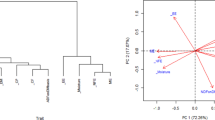Summary
One of the potential uses of Jerusalem artichoke (Helianthus tuberosus L.) is as a forage crop. Information on inherent differences in forage nutritional quality is essential if the quality of the forage is to be improved through breeding. The objectives of this study were to determine the genotypic variability among and within forage of Jerusalem artichoke cultivars for the concentration of N, P, Ca, Mg, K and the Ca/P ratio at flowering, to determine if selection among and within cultivars is feasible, to estimate the magnitude of the genotype × environment interaction, and to examine the relationships among mineral concentrations in the forage. Ten cultivated Jerusalem artichoke cultivars grown in an irrigated field nursery at Bushland, TX were evaluated for N, P, Ca, Mg, K, and the Ca/P ratio in the forage at flowering over a 2-yr period. Cultivars, cultivar × year, and error variances were estimated to calculate the phenotypic variance. Estimates of the within-population variances were also determined. The adequacy of Jerusalem artichoke forage at flowering for maintenance of a ruminant animal was classified as follows: N, Ca, Mg, K as adequate, P inadequate, and the Ca/P ratio as excessive. There were genotypic differences among the ten cultivars for N, P, Ca, Mg, K, and the Ca/P ratio for both years and averaged across years. The magnitude of the genotypic variance components indicated that a substantial proportion of the total variation for these elements was due to cultivar, indicating the possibility of improving these elements. However, further studies on heritability and response to selection will be required before conclusions can be reached concerning the likelihood of successfully breeding for these traits.
Similar content being viewed by others
References
Becker, W.A., 1984. Manual of quantitative genetics. 4th edn., Academic Enterprises, Pullman, WA.
Cosgrove, D.S., E.A. Oelke, J.D. Doll, D. Davis, D.J. Undersander & E.S. Oplinger, 2000. Alternate field crops manual: Jerusalem artichoke. Website: http://www.hort.purdue.edu/newcrop/afcm/jerusart.html
Crawford, H.S., C.L. Kucera & J.H. Ehrenreich, 1969. Ozark range and wildlife plants. USDA Agric Handb 356. U.S. Gov Print Office, Washington, DC.
Hanlon, E.A., 1992. Determination of potassium, calcium, and magnesium in plants by atomic adsorption techniques. In: C.O. Plank (Ed.) Plant analysis reference procedures for the southern region of the US, pp. 30–33. Southern Cooperative Series Bull. 368, University of Georgia and Georgia Agric Exp Stn, Athens, GA
Isaac, R.A. & J.D. Kerber, 1971. Atomic absorption and flame photometry: Techniques and uses in soil, plant, and water analysis of soils and plant tissue. In: L.M. Walsh (Ed.) Instrumental method for analysis, pp. 7–37. Soil Sci Soc Am, Madison, WI.
Jackson, M.L., 1958. Soil chemical analysis. Prentice Hall, Inc., Englewood Cliffs, NJ.
Jones, J.B., Jr. & W.J.A. Steyn, 1973. Sampling, handling, and analyzing plant tissue samples. In: L.M. Walsh & J.D. Beaton (Eds.) Soil testing and plant analysis, pp. 249–270. Soil Sci Soc Am, Madison, WI.
Kosaric, N., G.P. Cosentino, A. Wieczorek & Z. Duvnjak, 1984. The Jerusalem artichoke as an agricultural crop. Biomass 5: 1–36.
McLaurin, W.J., Z.C. Somda & S.J. Kays, 1999. Jerusalem artichoke growth, development, and field storage. I. Numerical assessment of plant part development and dry matter acquisition and allocation. J Plant Nutr 22: 1303–1313.
National Academy of Sciences, 1981. Nutrient requirements of goats: Angora, dairy, and meat goats. Natl Acad Sci, Washington, DC.
National Academy of Sciences, 1985. Nutrient requirements of sheep. 6th edn., Natl Acad Sci, Washington, DC.
National Academy of Sciences, 2000. Nutrient requirements of beef cattle. 7th edn., Natl Acad Sci, Washington, DC.
National Academy of Sciences, 2001. Nutrient requirements of dairy cattle. 7th edn., Natl Acad Sci, Washington, DC.
Reid, R.L. & L.F. James, 1985. Forage-animal disorders. In: M.E. Heath et al. (Eds.) Forages, 4th edn., pp. 430–444. Iowa State Univ Press, Ames, IA.
Schittenhelm, S., 1999. Agronomic performance of root chicory, Jerusalem artichoke, and sugarbeet in stress and nonstress environments. Crop Sci 39: 1815–1823.
Schneiter, A.A. & J.F. Miller, 1981. Description of sunflower growth stages. Crop Sci 21: 901–903.
Seiler, G.J., 1988. Nitrogen and mineral content of selected wild and cultivated genotypes of Jerusalem artichoke. Agron J 80: 681–687.
Seiler, G.J., 1993. Forage and tuber yields and digestibility of selected wild and cultivated genotypes of Jerusalem artichoke. Agron J 85: 29–33.
Seiler, G.J. & L.C. Campbell, 2004. Genetic variability for mineral element concentrations of wild Jerusalem artichoke forage. Crop Sci 44: 289–292.
Somda, Z.C., W.J. McLaurin & S.J. Kays, 1999. Jerusalem artichoke growth, development, and field storage. II. Carbon and nutrient element allocation and redistribution. J Plant Nutr 22: 1315–1334.
Stauffer, M.D., B.B. Chubey & D.G. Dorrell, 1975. Jerusalem artichoke: Formulating the potential of a new crop. Can Agric 20: 34–35.
Swanton, C.J. & P.B. Cavers, 1989. Biomass and nutrient allocation patterns in Jerusalem artichoke (Helianthus tuberosus). Can J Bot 67: 2880–2887.
Technicon Corporation, 1968. Technicon auto analyzer methodology. Industrial method INDL-8. Tarrytown, NY.
Tilley, J.M.A & R.A. Terry, 1963. A two-stage technique for the in vitro digestion of forage crops. J Brit Grassl Soc 18: 104–111.
Vogel, K.P., H.F. Mayland, P.E. Reece & J.F.S. Lamb, 1989. Genetic variability for mineral concentration of crested wheatgrass forage. Agron J 29: 1146–1150.
Wall, D.A., F.A. Kiehn & G.E. Friesen, 1986. Control of Jerusalem artichoke (Helianthus tuberosus) in barley (Hordeum vulgare). Weed Sci 34: 761–764.
Wyse, D.L., F.L. Young & R.J. Jones, 1986. Influence of Jerusalem artichoke (Helianthus tuberosus) density and duration of interference on soybean (Glycine max) growth and yield. Weed Sci 34: 243–247.
Youngen, J.A., 1992. Jerusalem artichoke trials in southern Oregon. Special Rpt. 905. Agric Exp Stn, Oregon State Univ, Corvallis, OR.
Author information
Authors and Affiliations
Corresponding author
Rights and permissions
About this article
Cite this article
Seiler, G.J., Campbell, L.G. Genetic Variability for Mineral Concentration in the Forage of Jerusalem Artichoke Cultivars. Euphytica 150, 281–288 (2006). https://doi.org/10.1007/s10681-006-9119-2
Received:
Accepted:
Published:
Issue Date:
DOI: https://doi.org/10.1007/s10681-006-9119-2




